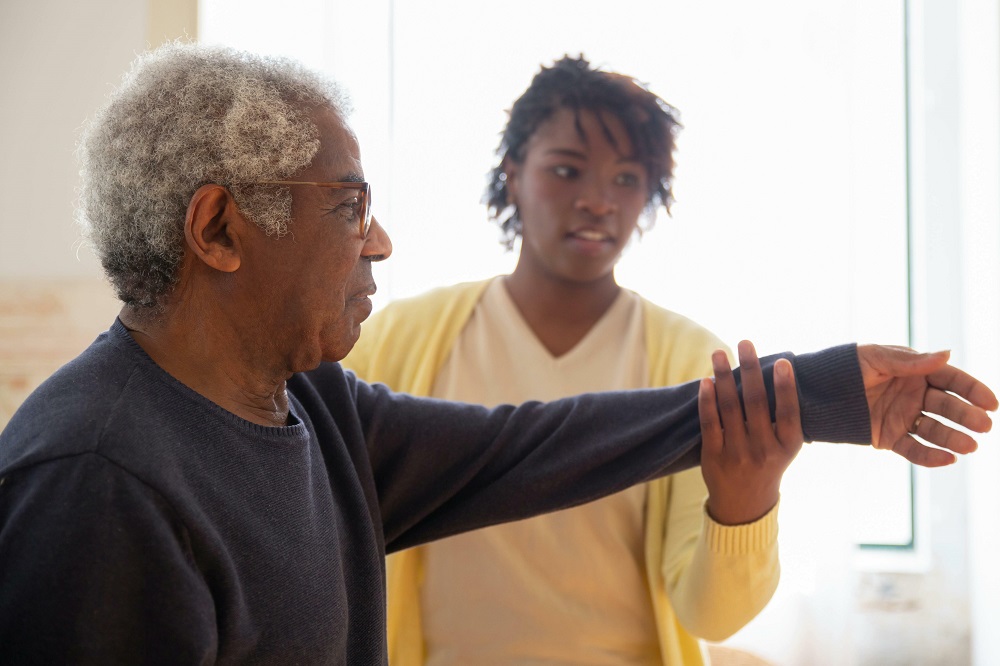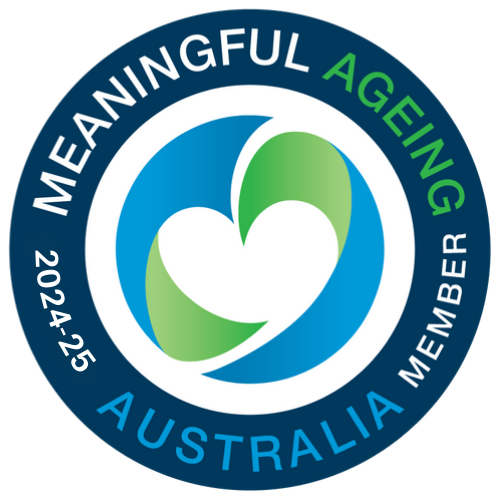One in three people aged 65 and older fall each year. About 10% fall more than once, and over 30% are injured and need medical care. Thus, the risk of falls and serious injuries rises with age.
As a caregiver, it’s important to include activities that improve balance and stability in seniors’ routines to prevent falls. Regular fall prevention exercises can greatly enhance a senior’s strength and balance, reducing the risk of falls.

In this article, you’ll learn seven easy exercises for seniors to do at home to prevent falls and improve their quality of life. You’ll also learn tips on how to handle a fall if it happens.
This guide will give you a better understanding of the following:
- Common Causes of Falls in Seniors: Understand the reasons why seniors are at high risk of falling
- Importance of Regular Exercise for Seniors: Learn why maintaining physical strength and balance is crucial for preventing falls in the elderly.
- Specific Exercises for Fall Prevention: Discover detailed steps for seven simple exercises that can be performed safely at home to improve stability and mobility.
- Benefits of Each Exercise: Understand how each exercise contributes to reducing the risk of falls and enhancing overall health and independence.
- Post Fall Management Tips in Aged Care: Learn the immediate and follow-up care that seniors should receive for their recovery and ongoing safety.
You’ll be ready to add these exercises into daily routines, ensuring a safer and more active lifestyle for yourself or your loved ones.
What are the Common Causes of Falls in Seniors?
Falls in seniors can be caused by a mix of physical, medical, and environmental issues. Common causes include:
- Muscle Weakness: Weak leg muscles increase the risk of falls.
- Balance and Gait: Aging can reduce coordination, flexibility, and balance, making falls more likely.
- Poor Vision: Eye conditions like cataracts and glaucoma can make it hard to see obstacles and judge depth, leading to falls.
- Medications: Some drugs, such as sedatives and heart medications, can affect balance and thinking, increasing fall risk.
- Chronic Diseases: Conditions like Parkinson’s, Alzheimer’s, arthritis, diabetes, and heart disease can affect balance, mobility, and strength.
- Environmental Hazards: Loose rugs, slippery floors, poor lighting, uneven surfaces, clutter, stairs without railings, and bathrooms without grab bars can cause falls.
- Improper Footwear: Shoes that are loose, have slippery soles, or lack support can lead to falls.
- Psychological Factors: Fear of falling can cause less activity, leading to physical decline and again, more falls.
Understanding these factors helps you understand why falls happen among seniors and help you address and reduce the specific risks they face.
Why Does Exercise Helps Prevent Falls in Seniors?
Exercise plays a crucial role in falls prevention in aged care. It addresses several of the key factors that contribute to the risk of falling. Here’s why and how exercise is effective:
- Improves Muscle Strength: Regular exercise strengthens leg and core muscles, essential for stability and mobility. Stronger muscles make it easier for seniors to stand, sit, and maintain balance.
- Enhances Balance and Coordination: Balance exercises, like tai chi, help improve the ability to stay balanced during movement, reducing fall risk.
- Increases Flexibility: Stretching exercises maintain joint flexibility, allowing for smoother movements and safer daily activities.
- Promotes Better Gait: Targeted exercises can improve the way seniors walk, making their steps more stable and reducing the risk of tripping or stumbling.
- Boosts Bone Density: Weight-bearing exercises, like walking, dancing, or gentle strength training, can help build bone density and prevent osteoporosis, a condition that makes bones more fragile and more likely to break during a fall.
By adding regular, tailored exercise to their daily routines, seniors can greatly reduce their risk of falls, maintain independence, and improve their overall quality of life.
What Simple Fall Prevention Exercises can Seniors Do?
Here are some effective exercises for older adults to prevent falls:
1. Toe Taps
Toe taps are great for strengthening the lower legs, helping to lift feet and prevent tripping. Here’s how seniors can do toe taps:
- Instruct the senior to sit in a sturdy chair with their feet flat on the ground.
- Guide them to lift the toes of one foot while keeping the heel firmly on the floor.
- Ask them to lower the toes back to the ground and repeat this movement 10-15 times.
- Then, have them switch to the other foot and perform the same exercise. Ensure they maintain good posture throughout the activity.
This exercise strengthens the shin muscles, which are crucial for walking and climbing stairs safely. It’s one of the simplest leg exercises for seniors to do at home.
2. Heel Raises
Heel raises strengthen the upper calf muscles, which helps one’s body move forward and aids in balance:
- Ask the senior to stand behind a sturdy chair for support.
- Guide them to lift their heels off the ground, balancing on their toes.
- Have them hold this position for a few seconds, then slowly lower their heels back to the ground.
- Encourage them to repeat this 10-15 times to help build strength in their ankles and improve their balance.
Performing heel raises regularly can help seniors maintain their stability, making walking and other activities safer.
3. Marching in Place
Marching in place is a simple exercise that significantly boosts coordination and leg strength:
- Instruct the senior to stand behind a chair with their feet hip-width apart for stability.
- Guide them to lift one knee as high as is comfortable for them, then gently lower it back down, alternating between legs.
- Encourage them to continue this ‘marching’ in place for 1-2 minutes.
This activity strengthens the legs and enhances balance, crucial for preventing falls. It’s one of the tried-and-tested exercises for older adults to prevent falls.
4. Side Leg Raises
Side leg raises strengthen the hips and thighs, key areas for maintaining balance during side-to-side movements:
- Ask the senior to stand beside a chair for support.
- Guide them to slowly lift one leg to the side, keeping both their back and the lifted leg straight.
- Have them hold the position for a few seconds, then gently lower the leg back down.
- Encourage them to perform 10-15 repetitions on each side.
This exercise helps strengthen their hip abductors. Strengthening these muscles is essential because it helps improve balance, especially when walking or turning quickly.
5. Sit-to-Stands
- Let the senior start in a seated position in a sturdy chair.
- Guide them to stand up straight without using their hands for support, and then slowly sit back down.
- Encourage them to repeat this motion 10-15 times. Ensure they perform the movement slowly and safely to maintain balance and control.
This exercise helps improve muscle strength and joint flexibility, important for maintaining independence in daily tasks. It is also one of the easiest exercises for seniors to do at home with minimal equipment needed.
6. Back Leg Raises
Back leg raises focus on the lower back and buttock muscles, helping maintain an upright posture and stability:
- Ask the senior to stand behind a chair for support.
- Guide them to lift one leg straight back without bending the knee or pointing the toes.
- Have them hold this position for a few seconds, then return to the starting position.
- Encourage them to repeat this 10-15 times with each leg. Make sure they keep a light hold on the chair to ensure stability throughout the exercise.
These muscles play a significant role in walking and stability, helping to prevent backward falls. Additionally, strengthening these areas can alleviate lower back pain and improve posture.
Regular practice of all these exercises can greatly reduce the risk of falls by improving physical health and stability.
Post Fall Management Tips in Aged Care
It’s not enough to know how to prevent falls from happening. In case the accident happens, it’s also important to know how to respond appropriately. Falls can be a serious concern for the elderly. As such, it’s important that seniors receive appropriate care after any fall. Here’s a comprehensive approach to handling and managing a fall.
1. Immediate Response
The first priority is assessing the resident for any injuries or medical needs. This includes:
- Checking for visible injuries such as bruises, cuts, or potential fractures.
- Assessing the senior’s cognitive state to see if they are confused or disoriented.
- Look for signs of pain, discomfort, or inability to move.
- Seeking medical help if there are serious injuries or pain.
2. Comfort and Reassurance
Provide comfort and reassurance to the senior. Falls can be traumatic, leading to fear and anxiety about future falls. Speaking in a calm and reassuring voice helps reduce their stress and anxiety.
3. Documentation
Every fall should be thoroughly documented in the senior’s care record. This documentation should include:
- The time and location of the fall.
- Activities that were being performed at the time of the fall.
- Any witnesses to the incident.
- The senior’s description of the fall and any expressed symptoms.
- Details of the initial assessment and any actions taken.
4. Notify Relevant Parties
Family members and healthcare providers should be informed about the incident, particularly if it resulted in significant injury or marks a change in the senior’s health or mobility status.
5. Follow-Up Care
Based on the assessment, appropriate follow-up care should be provided. This might include:
- Further medical evaluation, such as x-rays or scans.
- Physical or occupational therapy to address any new or exacerbated mobility or health issues.
- Monitoring for signs of delayed complications like concussion or internal injuries.
6. Review and Modify Care Plan
The senior’s care plan should be reviewed and possibly adjusted to meet their current needs, which might have changed after the fall. Adjustments could include:
- Increased supervision during certain activities.
- Additional mobility aids.
- Changes in medication if dizziness or other side effects may have contributed to the fall
- Modifying the environment in case it contributed to the fall (e.g. improving the lighting or removing trip hazards)
Effective post-fall management addresses the immediate effects of a fall and incorporates strategic changes to care practices and the environment to prevent future incidents.
Final Words
Including these exercises into the daily routine of seniors is pivotal in falls prevention in aged care. By strengthening important muscle groups, enhancing flexibility, and improving overall balance, you can help seniors reduce their fall risks.
A proactive approach to fall prevention is crucial for maintaining a safe and active lifestyle for older adults, helping them stay independent and healthy.
For seniors or their caregivers looking for more comprehensive guides on maintaining health and managing post-fall management in aged care, visit Vital Home Health for valuable resources and information. Check our blogs here.
References:
Falls prevention among older Victorians (2023) Department of Health. Victoria, Australia. Available at: https://www.health.vic.gov.au/your-health-report-of-the-chief-health-officer-victoria-2018/injury-prevention/falls-prevention (Accessed: 26 April 2024).
Info about falls (2024) Australia and New Zealand Falls Prevention Society. Available at: https://www.anzfallsprevention.org/info/#:~:text=Falls%20are%20a%20major%20health,8.1%20million%20people)%20in%202050. (Accessed: 26 April 2024)








